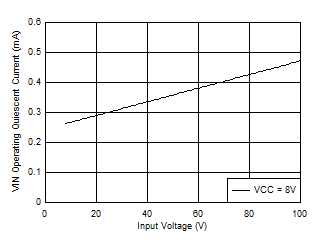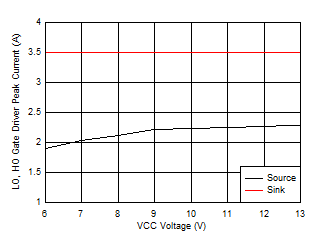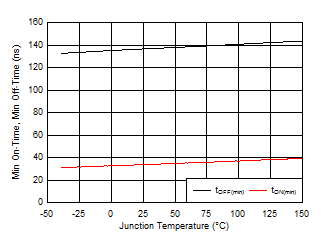JAJSJD3A June 2021 – June 2021 LM5146
PRODUCTION DATA
- 1 特長
- 2 アプリケーション
- 3 概要
- 4 Revision History
- 5 概要 (続き)
- 6 Pin Configuration and Functions
- 7 Specifications
-
8 Detailed Description
- 8.1 Overview
- 8.2 Functional Block Diagram
- 8.3
Feature Description
- 8.3.1 Input Range (VIN)
- 8.3.2 Output Voltage Setpoint and Accuracy (FB)
- 8.3.3 High-Voltage Bias Supply Regulator (VCC)
- 8.3.4 Precision Enable (EN/UVLO)
- 8.3.5 Power Good Monitor (PGOOD)
- 8.3.6 Switching Frequency (RT, SYNCIN)
- 8.3.7 Configurable Soft Start (SS/TRK)
- 8.3.8 Voltage-Mode Control (COMP)
- 8.3.9 Gate Drivers (LO, HO)
- 8.3.10 Current Sensing and Overcurrent Protection (ILIM)
- 8.3.11 OCP Duty Cycle Limiter
- 8.4 Device Functional Modes
- 9 Application and Implementation
- 10Power Supply Recommendations
- 11Layout
- 12Device and Documentation Support
- 13Mechanical, Packaging, and Orderable Information
パッケージ・オプション
メカニカル・データ(パッケージ|ピン)
- RGY|20
サーマルパッド・メカニカル・データ
- RGY|20
発注情報
7.7 Typical Characteristics
VVIN = 48 V, RRT = 25 kΩ, SYNCIN tied to VCC, EN/UVLO tied to VIN (unless otherwise noted).
 Figure 7-3 FB
Voltage vs Junction Temperature
Figure 7-3 FB
Voltage vs Junction Temperature
| VSW = 0 V | VEN/UVLO = 0 V |

| VSW = 0 V | VEN/UVLO = VVIN | VSS/TRK = 0 V |

| VSW = 0 V | VVCC = VBST = VILIM | VFB = 0 V |

| VSW = 0 V |
 Figure 7-13 BST
UVLO Thresholds vs Junction Temperature
Figure 7-13 BST
UVLO Thresholds vs Junction Temperature Figure 7-15 PGOOD
OVP Thresholds vs Junction Temperature
Figure 7-15 PGOOD
OVP Thresholds vs Junction Temperature

| RRT = 25 kΩ |
 Figure 7-21 Gate
Driver Peak Current vs VCC Voltage
Figure 7-21 Gate
Driver Peak Current vs VCC Voltage

| VIN = 5.5 V |
 Figure 7-27 BST
Diode Forward Voltage vs Current
Figure 7-27 BST
Diode Forward Voltage vs Current Figure 7-4 tON(min) and tOFF(min) vs Junction
Temperature
Figure 7-4 tON(min) and tOFF(min) vs Junction
Temperature
| VSW = 0 V | VEN/UVLO = 1 V |

| VSW = 0 V | HO, LO Open |
 Figure 7-10 ILIM
Current Source vs Junction Temperature
Figure 7-10 ILIM
Current Source vs Junction Temperature Figure 7-12 VCC
UVLO Thresholds vs Junction Temperature
Figure 7-12 VCC
UVLO Thresholds vs Junction Temperature Figure 7-14 PGOOD
UVP Thresholds vs Junction Temperature
Figure 7-14 PGOOD
UVP Thresholds vs Junction Temperature Figure 7-16 EN/UVLO Threshold vs Junction Temperature
Figure 7-16 EN/UVLO Threshold vs Junction Temperature
| VSW = 0 V |

| RRT = 10 kΩ |
 Figure 7-22 HO
Driver Resistance vs VCC Voltage
Figure 7-22 HO
Driver Resistance vs VCC Voltage
| VSS/TRK = 0 V |

| VIN = 12 V |
 Figure 7-28 SS/TRK Current Source vs Junction Temperature
Figure 7-28 SS/TRK Current Source vs Junction Temperature
